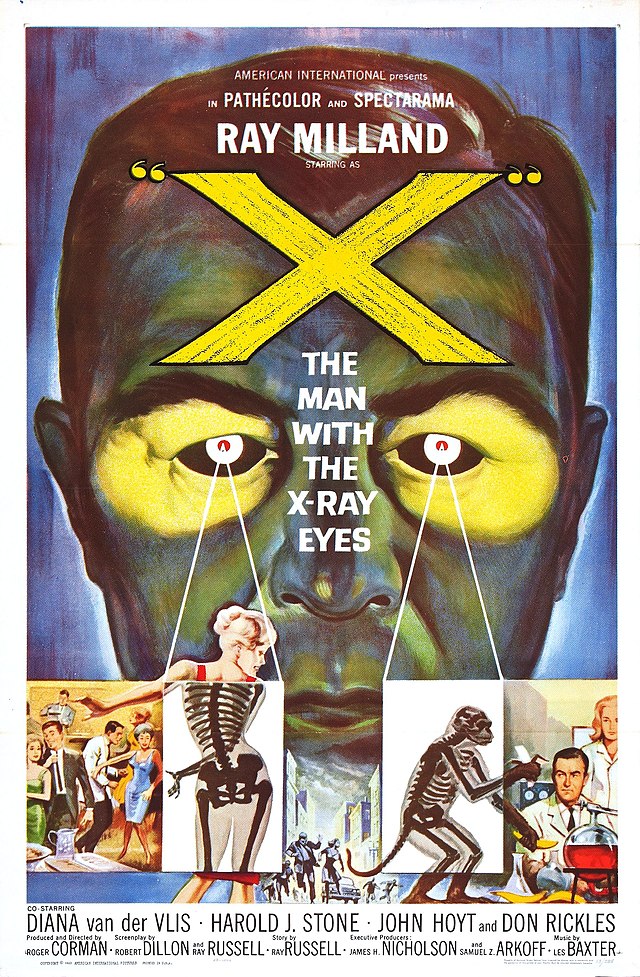Seeking a Dose of ‘Disreputable Cinema’? Check Out Roger Corman’s ‘X: The Man With The X-Ray Eyes’
A fervent believer in pinching pennies, turning a profit, and working on the quick, the recently deceased Corman pursued films geared to audiences that were young, prurient, and eager for a thrill.

The Museum of the Moving Image hosts films under various rubrics to fulfill its avowed purpose of elaborating upon how “the moving image … shapes how we see and feel the world.” Some of the programs are locally focused, including the borough-specific “Queens On Screen” and the Astoria-adjacent “Always On Sunday: Greek Film Series.” Other categories are particular to an era (“Silents, Please!”), a genre (“New Adventures in Non-Fiction”), and a scale (“See It Big: 70 MM”).
MoMI instituted “Science On Screen” in 2017 with assistance from the Alfred P. Sloan Foundation and the guidance of a curator of science and technology, Sonia Epstein. A casual observer might think that Ms. Epstein’s latest pick, “X: The Man With The X-Ray Eyes” (1963), screening this weekend, has been chosen in memory of the recent passing of the “King of the B’s” filmmaker, Roger Corman. “Trust the science” we know about, but how trustworthy could a drive-in potboiler be?
MoMI is also screening “The Man With The X-Ray Eyes” under the auspices of “Disreputable Cinema,” or what was known in less polite times as “Cult Movies.” Pretty much everything Corman put his hand to merits the designation. A fervent believer in pinching pennies, turning a profit, and working on the quick, Corman pursued films geared to audiences that were young, prurient, and eager for a thrill. As such, their subjects tend to the sensational, the lurid, and the horrific — which isn’t to suggest that scientists shouldn’t have fun.
Corman’s picture is fun, particularly when we watch middle-aged Dr. James Xavier (Ray Milland) amble through a party in which its clean-cut participants cut-a-rug to a rock ‘n’ roll ditty that probably sounded fusty in 1962. When Dr. Xavier attempts to shake a leg, he’s taken aback: Everyone in the vicinity appears to be naked, including his date for the evening, a surprisingly nonplussed Dr. Diane Fairfax (Diana van Der Vlis). Those experimental drops Dr. Xavier recently applied to his eyes to amplify his sight? They work very well, indeed.

By contemporary standards, this scene is chaste. Promises of naked dancing undoubtedly prompted ticket sales — particularly, among adolescent boys. All the same, “The Man With The X-Ray Eyes” is an odd man out as an exploitation picture. Notwithstanding a sensationalistic conceit, Corman’s movie teeters on the philosophical and the poetic. The psychedelic auroras generated by the underwhelming cinematic gimmick Spectarama matter less than the bad decisions made by otherwise reasonable people in the storyline.
The movie starts off with an icky close-up of an eyeball floating in a jar. Then it’s down to business: Dr. Xavier is conducting laboratory experiments done in the name of increasing humankind’s ability to see. Our eyes, he tells a colleague, take in “less than one-tenth of the actual wave spectrum. What could we really see if we had access to the other 90 percent?” Like a typical B-movie scientist, Dr. Xavier has grandiose ambitions: “closing in on the gods.”
The foundation sponsoring Dr. Xavier’s research pulls the plug on his funding. All the while, he’s been employing himself as the subject for his experiments. Initially, the results prove amusing — those nude dancers, remember — and then they become troubling. When Dr. Xavier is able to see inside the body of a dying young girl, he interrupts a surgery-in-progress to save her life. Threats of malpractice are nothing compared to the burden of seeing beyond the ken of human experience.
Dr. Xavier goes on the lam and begins working as a mind-reader for sideshow huckster Crane (comedian Don Rickles). When “Mr. Mentallo” is strong-armed by Crane to change his act and become a faith-healer for the poor, “The Man With The X-Ray Eyes” takes a strange turn. Dr. Xavier becomes increasingly taxed by his inability to not see and begins to wish for darkness. By the end of the film, he’s distraught and bedraggled. Dr. Xavier wanders through the wilderness and into an itinerant church revival meeting.
The attending preacher accuses Dr. Xavier of being in cahoots with the devil and dispenses biblical advice that is abrupt in nature and will not go spoken here. The extremities that Dr. Xavier suffers are given weight and gravitas by Milland, an actor who had, at that point in his career, aged out of leading roles but never forgot he was a professional. Rickles is as callous as you’d expect and Van Der Vils spunkier than you might believe. As for Corman: He has his eye on the finish line and gets there without a lick of nonsense.
Somewhere, a Pop-besotted Ph.D. candidate is writing a dissertation on “X: “The Man With The X-Ray Eyes,” outlining how its sci-fi trappings embody the fruitlessness of hubris, the frustrations of absolute power, and the tenacity of sin. The biggest compliment you could give Corman’s film is that it does, in the end, merit scholarly attention.

